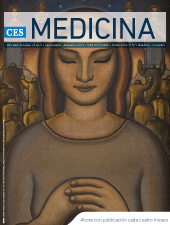Choque séptico fulminante neonatal por Clostridium perfringens
DOI:
https://doi.org/10.21615/cesmedicina.32.3.8Resumen
Clostridium spp. es un bacilo grampositivos, anaerobio, formador de esporas y ampliamente distribuido en el ambiente. Las infecciones por Clostridium perfringens en neonatos son en extremo raras. La sepsis grave por anaerobios, incluyendo el choque séptico, es un evento clínico inusual en este grupo de pacientes. Se reportan dos casos de bacteriemia por C. perfringens asociados a choque séptico fulminante en recién nacidos con enterocolitis necrosante grave.
Descargas
Referencias bibliográficas
Archile-Contreras AC, Purslow PP. Oxidative stress may affect meat quality by interfering with collagen turnover by muscle fibroblast. Food Res Int 2011; 44:582-588.
Boissy A, Manteuffel G, Jensen MB, Moe RO, Spruijt B, Keeling LJ, et al. Assement of positive emotions in animals to improve their welfare. Physiol Behav 2007; 92:375-397.
Boles JA, Kohlbeck KS, Meyers MC, Perz KA, Davis KC, Thomson JM. The use of blood lactate concentration as an indicator of temperament and its impact on growth rate and tenderness of steaks from Simmental X Angus steers. Meat Sci 2015; 103:68-74.
Cafazzo S, Magnani D, Calà P, Razzuoli E, Gerardi G, Bernardini D, et al. Effect of short road journeys on behaviour and some blood variables related to welfare in young bulls. Appl Anim Behav Sci 2012; 139:26-34.
Cockram MS, Baxter EM, Smith LA, Bell S, Howard CM, Prescott RJ, et al. Effect of driver behaviour, driving events and road type on the stability and resting behaviour of sheep in transit. J Anim Sci 2004; 79:165-176.
Dunne PG, Monahan FJ, Moloney AP. Current perspectives on the darker beef often reported from extensively-managed cattle: ¿Does physical activity play a significant role? Livest Sci 2011; 142:1-22.
Early E, Murray M, Prendiville DJ, Pintado B, Borque C, Canal E. The effect of transport by road and sea on physiological, immunity and behavior of beef cattle. Res Vet Sci, 2012; 92:531-541.
Ferguson DM, Warner RD ¿Have we underestimated the impact of pre-slaughter stress on meat quality in ruminants? Meat Sci 2008; 80:12-19.
Fox J, Widowski T, Torrey S, Nannoni E, Bergeron R, Gonyou HW, et al. Water sprinkling market pigs in a stationary trailer. 1. Effects on pig behaviour, gastrointestinal tract temperature and trailer micro-climate. Livest Sci 2014; 160:113-123.
Gallo C, Lizondo G, Knowles TG. Effects of journey and lairage time on steers transported to slaughter in Chile. Vet Rec 2003; 152:361-364.
Hambrecht E, Eissen JJ, Newman DJ, Smits CH, den Hartog LA, Verstegen MW. Negative effects of stress immediately before slaughter on pork quality are aggravated by suboptimal transport and lairage conditions. J Anim Sci 2005; 83:440-448.
Immonen K, Puolanne E. Variation of residual glycogen-glucose concentration al ultimate pH values below 5.75. Meat Sci 2000; 55:279-283.
Kaneko J, Harvey J, Bruss M. Clinical Biochemistry of domestic animals. 6ta ed. Estados Unidos: Elsevier Academic Press; 2008
Kannan G, Kouakou B, Terril TH & Gelaye S. Endocrine, blood metabolite, and meat quality changes in goats as influenced by short-term, preslaughter stress. J Anim Sci 2003; 81:1499-1507.
Lambooij E, Van Der Werf JTN, Reimert HGM, Hindle VA. Compartment height in cattle transport vehicles. Livest Sci, 2012; 148:87-94.
Magnani D, Cafazzo S, Calà P, Razzuoli E, Amadori M, Bernardini D, et al. Effect of long transport and environmental conditions on behavior and blood parameters of postweaned piglets with different reactivity to backtest, Livest Sci 2014; 162:201-208.
Mather AE, Innocent GT, Mcewen SA, Reilly WJ, Taylor DJ, Steele WB, et al. Risk factors for hide contamination of Scottish cattle at slaughter with Escherichia coli O157. Prev Vet Med 2007; 80:257-270.
Millman ST, Duncan IJH. Social Cognition of Farm Animals. En: Keeling L, Gonyou H. Social Behaviour in Farm Animals. 1ra ed. Estados Unidos: CABI Publishing; 2001. p. 373-400.
Miranda-De La Lama GC, Mattiello GC. The importance of social behavior for goat welfare in livestock farming. Small Ruminant Res 2010; 90:1-10.
Miranda-De La Lama GC, Sepúlveda WS, Villarroel M, Olleta, JL, García-Belenguer S, Maria GA. Livestock vehicle accidents in Spain: causes, consequences, and effects on animal welfare. J Appl Anim Welf Sci 2011; 14:109-123.
Miranda-De La Lama GC, Villarroel M, María GA. Behavioural and physiological profiles following exposure to novel environmental and social mixing in lambs. Small Ruminant Res 2012; 103:158-163.
Mounier L, Veissier I, Boissy A. Behavior, physiology, and performance of bulls mixed at the onset of finishing to form uniform body weight groups. J Anim Sci, 2005; 83:1696-1704.
Radostis OM, Ray CC, Hinchcliff KW, Constable PD, Veterinary medicine. 10ma ed. Estados Unidos: Saunders Elsevier; 2007.
Romero MH, Gutiérrez C, Sánchez JA. Evaluation of bruises as an animal welfare indicator during pre-slaughter of beef cattle. Rev Colomb Cien Pec 2012; 25:267-275.
Romero MH, Uribe-Veláquez LF, Sánchez JA. Physiological profiles of Zebu steers during transport and pre-slaughter. Rev Colomb Cien Pec 2014; 27:282-289.
Romero MH, Uribe-Velásquez LF, Sánchez JA, Miranda-De La Lama GC. Risk factors influencing bruising and high muscle pH in Colombian cattle carcasses due to transport and pre-slaughter operations. Meat Sci, 2013; 95:256-263.
Stockman CA, Collins T, Barnes AL, Miller D, Wickham SL, Beatty DT, et al. Flooring and driving conditions during road transport influence the behavioural expression of cattle. Appl Anim Behav Sci 2013; 143:18-30.
Tadich N, Gallo C, Echeverría R, Van Schaik G .2003. Efecto del ayuno durante dos tiempos de confinamiento y de transporte terrestre sobre algunas variables sanguíneas indicadoras de estrés en novillos. Arch Med Vet 2003; 2:171-185.
Tarrant V, Grandin T .2000. Cattle transport. En: Grandin T. Livestock handling and transport. 2da ed. Estados Unidos: CABI Publication; 2000. p. 151-173.
Temple D, Manteca X, Velarde A, Dalmau A. Assessment of animal welfare though behavioural parameters in Iberian pigs in intensive and extensive conditions. Appl Anim Behav Sci 2011; 131:29-39.
Van De Water G, Verjans F, Geers R. The effect of short distance transport under commercial conditions on the physiology of slaughter calves; pH and colour profiles of veal. Livest Prod Sci 2003; 82:171-179.
Descargas
Publicado
Cómo citar
Número
Sección
Licencia

Esta obra está bajo una licencia internacional Creative Commons Atribución-NoComercial-CompartirIgual 4.0.
Derechos de reproducción (copyright)
Cada manuscrito se acompañará de una declaración en la que se especifique que los materiales son inéditos, que no han sido publicados anteriormente en formato impreso o electrónico y que no se presentarán a ningún otro medio antes de conocer la decisión de la revista. En todo caso, cualquier publicación anterior, sea en forma impresa o electrónica, deberá darse a conocer a la redacción por escrito.
Plagios, duplicaciones totales o parciales, traduccones del original a otro idioma son de responsabilidad exclusiva de los autores el envío.
Los autores adjuntarán una declaración firmada indicando que, si el manuscrito se acepta para su publicación, los derechos de reproducción son propiedad exclusiva de la Revista CES Medicina.
Se solicita a los autores que proporcionen la información completa acerca de cualquier beca o subvención recibida de una entidad comercial u otro grupo con intereses privados, u otro organismo, para costear parcial o totalmente el trabajo en que se basa el artículo.
Los autores tienen la responsabilidad de obtener los permisos necesarios para reproducir cualquier material protegido por derechos de reproducción. El manuscrito se acompañará de la carta original que otorgue ese permiso y en ella debe especificarse con exactitud el número del cuadro o figura o el texto exacto que se citará y cómo se usará, así como la referencia bibliográfica completa.
| Estadísticas de artículo | |
|---|---|
| Vistas de resúmenes | |
| Vistas de PDF | |
| Descargas de PDF | |
| Vistas de HTML | |
| Otras vistas | |



